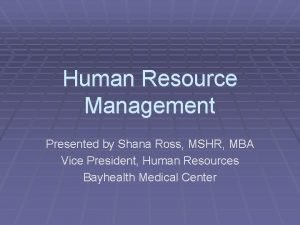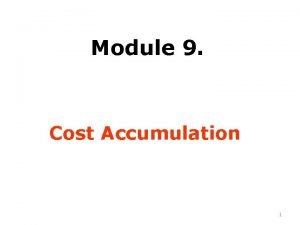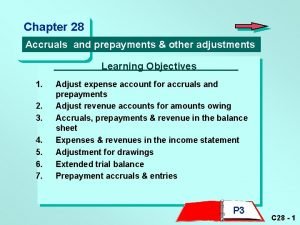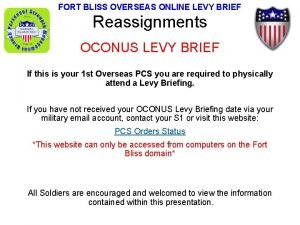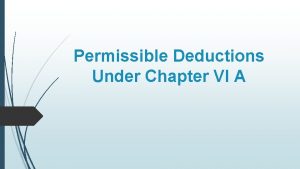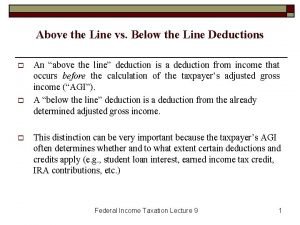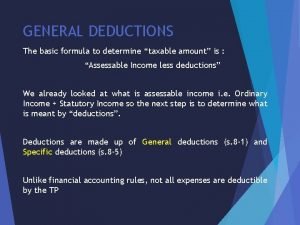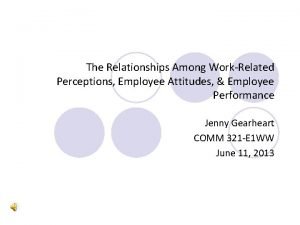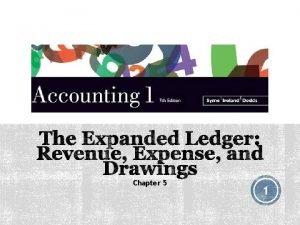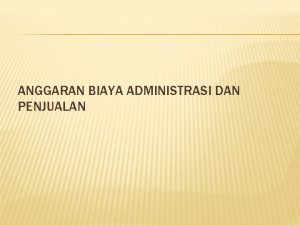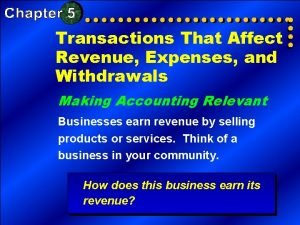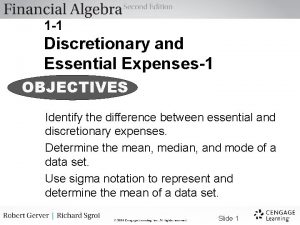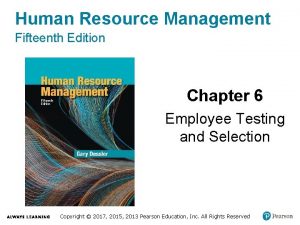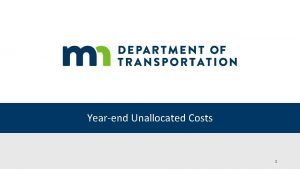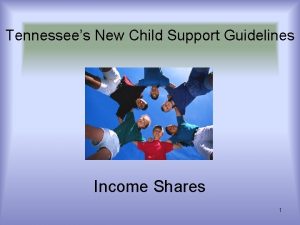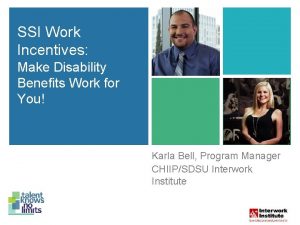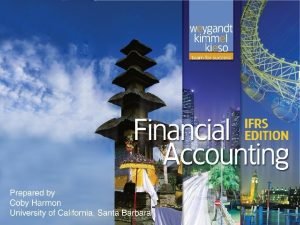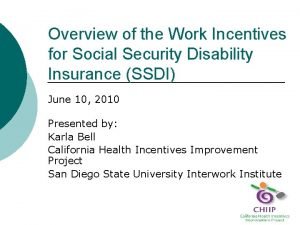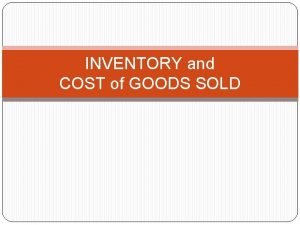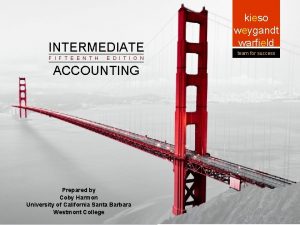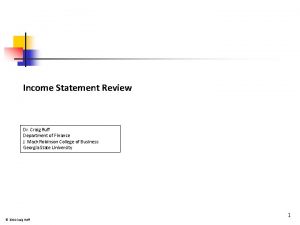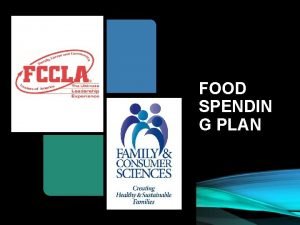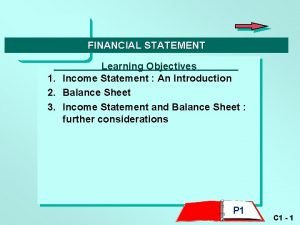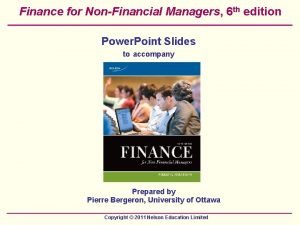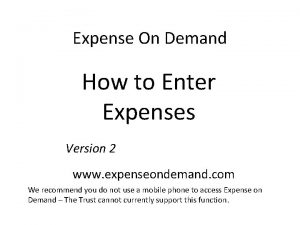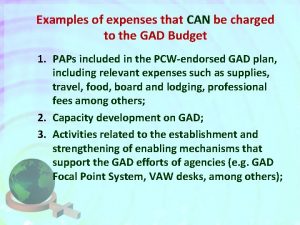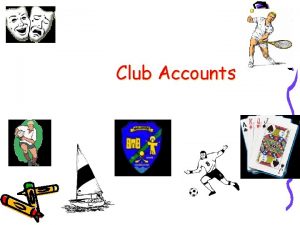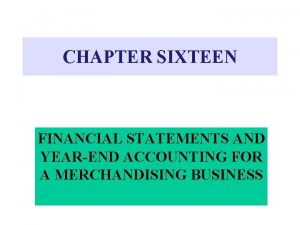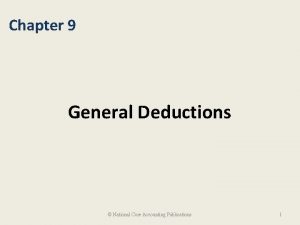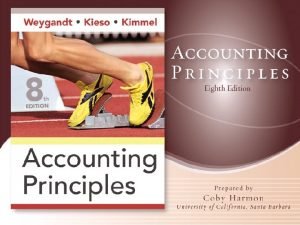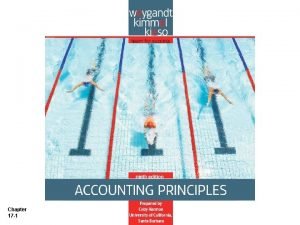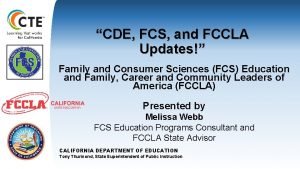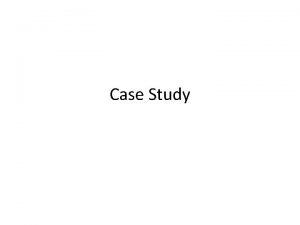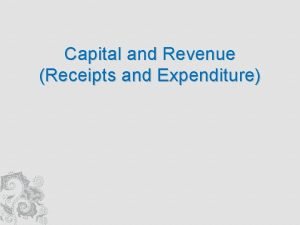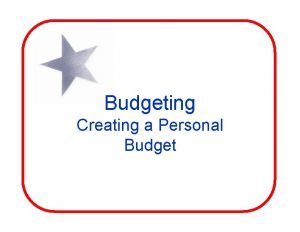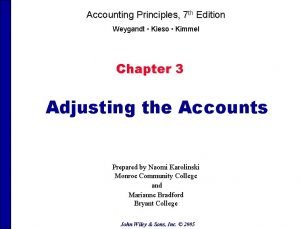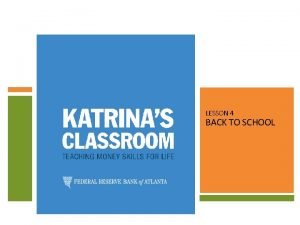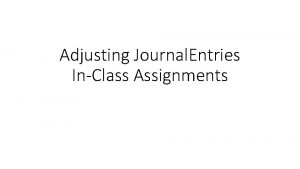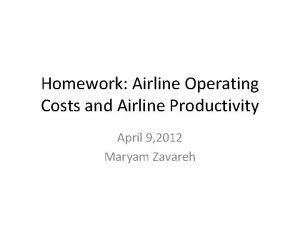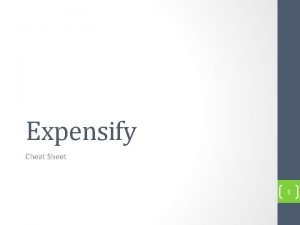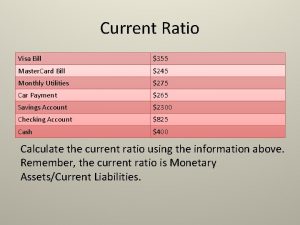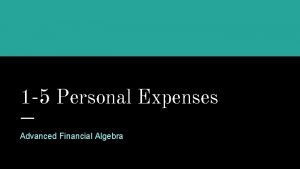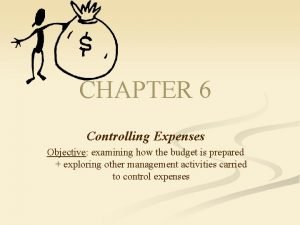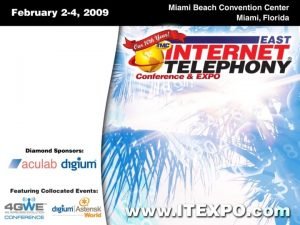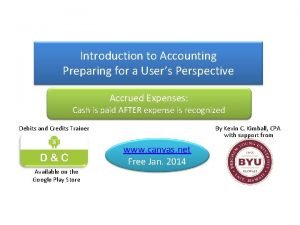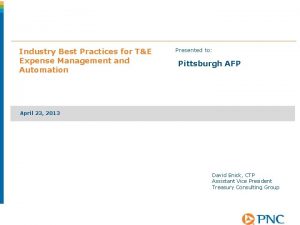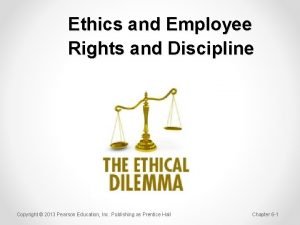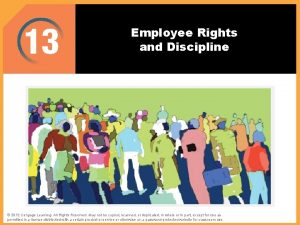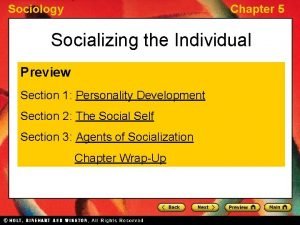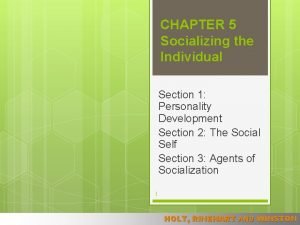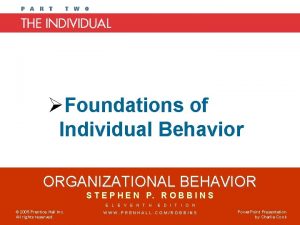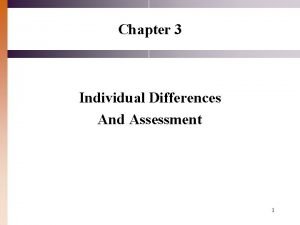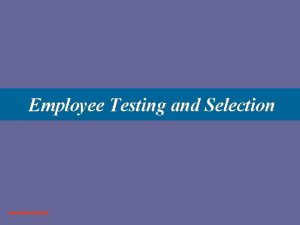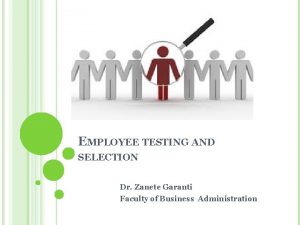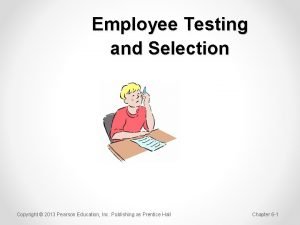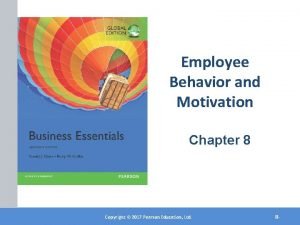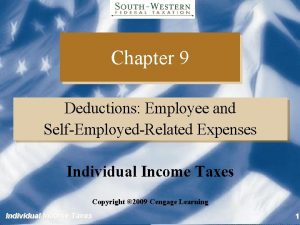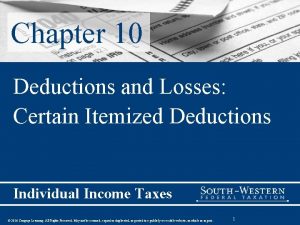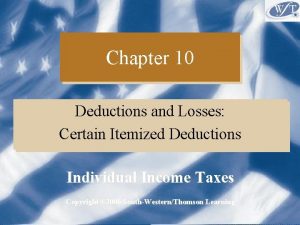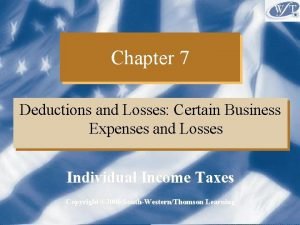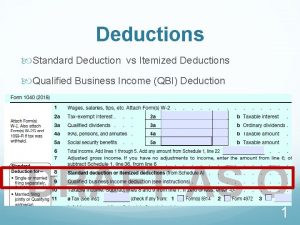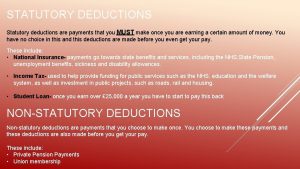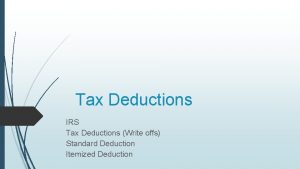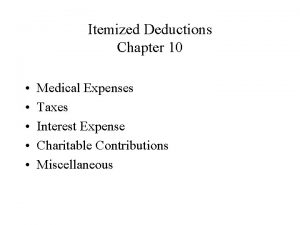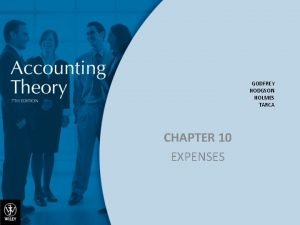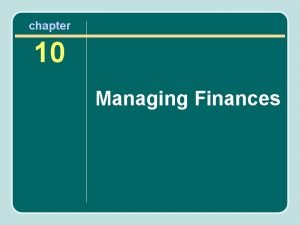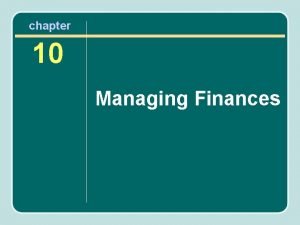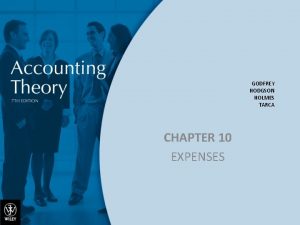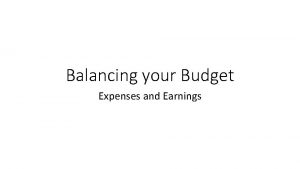CHAPTER 9 Deductions Employee and SelfEmployedRelated Expenses Individual










































































- Slides: 74

CHAPTER 9 Deductions: Employee and Self-Employed-Related Expenses Individual Income Taxes © 2019 Cengage Learning. All Rights Reserved. May not be scanned, copied or duplicated, or posted to a publicly accessible website, in whole or in part.

The Big Picture (slide 1 of 4) • Morgan, a recent college graduate who majored in child development, has accepted a job with Enrichment Child Care Center (ECCC) – At ECCC, Morgan will work with preschool children Monday to Friday from 7 A. M. to 3 P. M. • Because she is eager to pay off her student loans and save to buy a house, she has decided to freelance in the late afternoons and evenings and on weekends—joining the “gig economy. ” © 2019 Cengage Learning. All Rights Reserved. May not be scanned, copied or duplicated, or posted to a publicly accessible website, in whole or in part. 2

The Big Picture (slide 2 of 4) • She finds two ways to freelance: – (1) Transporting people, packages, and meals for a few companies where she finds work through the “app” (like driving for Uber), and – (2) Tutoring elementary school students in English and math. Her tutoring can take place online or in person (either in her apartment or at the home of the child). © 2019 Cengage Learning. All Rights Reserved. May not be scanned, copied or duplicated, or posted to a publicly accessible website, in whole or in part. 3

The Big Picture (slide 3 of 4) • She has dedicated the second bedroom in her apartment for freelancing. • She has a large table and several chairs in this bedroom that allow her to meet her tutoring students or connect with them via her laptop. – She keeps all of her freelancing records in a file cabinet, which she keeps in a closet in the bedroom. – She also purchases and keeps various supplies for her tutoring activities in the closet. © 2019 Cengage Learning. All Rights Reserved. May not be scanned, copied or duplicated, or posted to a publicly accessible website, in whole or in part. 4

The Big Picture (slide 4 of 4) • Although there are some freelance driving options in the suburbs, most often Morgan heads for the city, where there are more passengers and higher fares. • What are some of the income tax problems presented by this situation? • Read the chapter and formulate your response. © 2019 Cengage Learning. All Rights Reserved. May not be scanned, copied or duplicated, or posted to a publicly accessible website, in whole or in part. 5

Employee vs. Self-Employed (slide 1 of 2) • Business expenses for self-employed persons are deductible for AGI – Reported on Schedule C • Unreimbursed business expenses for employees are generally deductible from AGI as miscellaneous itemized deductions – However, from 2018 through 2025, the deduction for miscellaneous itemized deductions is suspended • As a result, there will be no tax benefit from these deductions during this period – The only employee business expenses that are currently deductible are those that are reimbursed by an employer • These expenses, once reimbursed, have no effect on an employee’s taxable income © 2019 Cengage Learning. All Rights Reserved. May not be scanned, copied or duplicated, or posted to a publicly accessible website, in whole or in part. 6

Employee vs. Self-Employed (slide 2 of 2) • Person is classified as an employee if: – Subject to will and control of another with respect to what shall be done and how it shall be done – Another furnishes tools or the place of work – Income based on time spent rather than task performed – Other factors © 2019 Cengage Learning. All Rights Reserved. May not be scanned, copied or duplicated, or posted to a publicly accessible website, in whole or in part. 7

Employee and Self-Employed Related Expenses • Fall into one of the following categories: – – – Transportation Travel Moving Education Entertainment Other (including office in the home and miscellaneous expenses) © 2019 Cengage Learning. All Rights Reserved. May not be scanned, copied or duplicated, or posted to a publicly accessible website, in whole or in part. 8

Transportation Expenses (slide 1 of 2) • Transportation expense defined – Very limited, only from job site to job site and commuting to/from temporary work place – Commuting from home to work and back is nondeductible • Exceptions: – Additional costs incurred to transport heavy tools – Employees with more than one job © 2019 Cengage Learning. All Rights Reserved. May not be scanned, copied or duplicated, or posted to a publicly accessible website, in whole or in part. 9

Transportation Expenses (slide 2 of 2) • Amount deductible – Actual expenses • Must keep adequate records of all expenses and depreciation is limited – Automatic mileage method • 54. 5 cents per mile for business miles for 2018 – Adjustment to basis of auto is required for depreciation considered allowed • Plus parking, tolls, etc. • Adequate documentation of mileage required © 2019 Cengage Learning. All Rights Reserved. May not be scanned, copied or duplicated, or posted to a publicly accessible website, in whole or in part. 10

The Big Picture - Example 5 Commuting Expense • Return to the facts of The Big Picture on p. 9 -1 • Because Morgan will have an office in her home, the apartment will be her principal place of business – Thus, any transportation from her home to freelancing sites (e. g. , driving to a child’s home for tutoring) is not a commuting expense. – However, Morgan will have commuting expenses for the mileage between her apartment and her job at Enrichment Child Care Center © 2019 Cengage Learning. All Rights Reserved. May not be scanned, copied or duplicated, or posted to a publicly accessible website, in whole or in part. 11

The Big Picture - Example 9 Automatic Mileage Method • Return to the facts of The Big Picture on p. 9 -1. • During Morgan’s senior year in college, her parents gave her one of the family cars—a 2014 Toyota Camry – Morgan has no idea as to the car’s original cost or the odometer reading at the time the car was registered in her name – She has, however, kept track of the miles driven for business since she accepted her new job • Morgan should use the automatic mileage method in claiming business use of the car © 2019 Cengage Learning. All Rights Reserved. May not be scanned, copied or duplicated, or posted to a publicly accessible website, in whole or in part. 12

The Big Picture - Example 10 Documenting Business Mileage • Return to the facts of The Big Picture on p. 9 -1. • Morgan wants to make sure she documents her business miles appropriately. She knows that the IRS expects her to keep track of her business miles. • A number of mileage tracking apps are available that would allow Morgan to begin logging miles automatically every time she started a trip including: – Mile. IQ (www. mileiq. com) – Trip. Log (https: //triplogmileage. com) – Quick. Books Self-Employed (https: //quickbooks. intuit. com/selfemployed/) – Stride Drive (http: //www. stridehealth. com/drive) © 2019 Cengage Learning. All Rights Reserved. May not be scanned, copied or duplicated, or posted to a publicly accessible website, in whole or in part. 13

Travel Expenses (slide 1 of 2) • Travel expense defined – Expenses while “away from tax home” overnight on business – Includes transportation, lodging, meals, and miscellaneous expenses © 2019 Cengage Learning. All Rights Reserved. May not be scanned, copied or duplicated, or posted to a publicly accessible website, in whole or in part. 14

Travel Expenses (slide 2 of 2) • “Away from home” requirement – Need not be a 24 -hour period but must be longer than ordinary work day and taxpayer will need to rest during release time – Being “away” should be a temporary situation (not in excess of 1 year) – “Tax Home” generally means business location, post, or station of the taxpayer – Some exceptions are allowed under new Regulations © 2019 Cengage Learning. All Rights Reserved. May not be scanned, copied or duplicated, or posted to a publicly accessible website, in whole or in part. 15

Restrictions on Travel Expenses (slide 1 of 2) • Convention travel expenses – No deduction for travel unless directly related to taxpayer’s trade or business • Example: Doctor attending out-of-town seminar on estate planning would not have deductible travel expenses – Restrictions apply to the deductibility of travel expenses of the taxpayer’s spouse or dependent • Generally, accompaniment by the spouse or dependent must serve a bona fide business purpose • The expenses must be otherwise deductible © 2019 Cengage Learning. All Rights Reserved. May not be scanned, copied or duplicated, or posted to a publicly accessible website, in whole or in part. 16

Restrictions on Travel Expenses (slide 2 of 2) • Education travel expenses – Travel as a form of education is not deductible • Example: Spanish language professor traveling to Spain to work on the language would not have deductible travel expenses • Example: Spanish history professor traveling to Spain to study historical documents available only in Spanish museums would have deductible travel expenses © 2019 Cengage Learning. All Rights Reserved. May not be scanned, copied or duplicated, or posted to a publicly accessible website, in whole or in part. 17

Combined Business/Pleasure Travel (slide 1 of 4) • Only actual expenses for business are deductible – Meals, lodging and other expenses must be allocated between business and personal days • Deductibility of transportation costs depends on whether the trip is domestic or foreign © 2019 Cengage Learning. All Rights Reserved. May not be scanned, copied or duplicated, or posted to a publicly accessible website, in whole or in part. 18

Combined Business/Pleasure Travel (slide 2 of 4) • For domestic travel – If primary purpose of trip is business, transportation is deductible in full – If primary purpose is pleasure, no deduction for transportation allowed, but other expenses (e. g. , lodging) associated with business days are deductible © 2019 Cengage Learning. All Rights Reserved. May not be scanned, copied or duplicated, or posted to a publicly accessible website, in whole or in part. 19

Combined Business/Pleasure Travel (slide 3 of 4) • For foreign travel – Transportation expenses must be allocated between business and personal unless: • Trip is 7 days or less • Less than 25% of time was for personal purposes, or • Taxpayer had no substantial control over arrangements for the trip © 2019 Cengage Learning. All Rights Reserved. May not be scanned, copied or duplicated, or posted to a publicly accessible website, in whole or in part. 20

Combined Business/Pleasure Travel (slide 4 of 4) • Travel days are considered business days • Weekends, legal holidays and intervening days are business days if both the preceding and succeeding days are business days • If trip is primarily for pleasure, no transportation expenses are deductible © 2019 Cengage Learning. All Rights Reserved. May not be scanned, copied or duplicated, or posted to a publicly accessible website, in whole or in part. 21

Education Expenses (slide 1 of 3) • Education expenses of a self-employed taxpayer are deductible if they are incurred: – To maintain or improve existing skills – To meet the specific legal requirements to keep his or her job © 2019 Cengage Learning. All Rights Reserved. May not be scanned, copied or duplicated, or posted to a publicly accessible website, in whole or in part. 22

Education Expenses (slide 2 of 3) • Education expenses are not deductible if they are incurred: – To meet minimum educational standards for existing job – To qualify taxpayer for new trade or business © 2019 Cengage Learning. All Rights Reserved. May not be scanned, copied or duplicated, or posted to a publicly accessible website, in whole or in part. 23

Education Expenses (slide 3 of 3) • Education expenses include: – – – Tuition Books Supplies Transportation Travel (including lodging and meals) © 2019 Cengage Learning. All Rights Reserved. May not be scanned, copied or duplicated, or posted to a publicly accessible website, in whole or in part. 24

Deduction For Qualified Tuition and Related Expenses (slide 1 of 3) • A deduction is allowed for AGI for qualified tuition and related expenses involving higher education (i. e. , postsecondary) – This provision expired on December 31, 2017, but might be extended by Congress. © 2019 Cengage Learning. All Rights Reserved. May not be scanned, copied or duplicated, or posted to a publicly accessible website, in whole or in part. 25

Deduction For Qualified Tuition and Related Expenses (slide 2 of 3) • The maximum deduction depends on filing status and Modified AGI © 2019 Cengage Learning. All Rights Reserved. May not be scanned, copied or duplicated, or posted to a publicly accessible website, in whole or in part. 26

Deduction For Qualified Tuition and Related Expenses (slide 3 of 3) • Qualified tuition and related expenses include whatever is required for enrollment – Usually, student activity fees, books, room and board are not included • Expenses need not be work related • Deduction is not available for married persons filing separately © 2019 Cengage Learning. All Rights Reserved. May not be scanned, copied or duplicated, or posted to a publicly accessible website, in whole or in part. 27

The Big Picture - Example 26 Education Expenses (slide 1 of 2) • Return to the facts of The Big Picture on p. 9 -1 • After starting her new job, Morgan enrolls in the evening master’s degree program in child development of a local university and begins attending classes © 2019 Cengage Learning. All Rights Reserved. May not be scanned, copied or duplicated, or posted to a publicly accessible website, in whole or in part. 28

The Big Picture - Example 26 Education Expenses (slide 2 of 2) • Return to the facts of The Big Picture on p. 9 -1 • Although Morgan believes that the master’s degree would be useful, it is – Not a requirement of ECCC, and – It is not needed to maintain or improve existing skills in her current job • As a result, except for the tuition she pays (see the discussion of § 222), none of her expenses relating to the education will be deductible © 2019 Cengage Learning. All Rights Reserved. May not be scanned, copied or duplicated, or posted to a publicly accessible website, in whole or in part. 29

Office in the Home (slide 1 of 2) • Deductibility is very restricted due to abuse possibilities – Office must be used exclusively and on a regular basis as: • The principal place of business, or • A place of business used by clients, patients, or customers • From 2018 through 2025, employees are not allowed an office in the home deduction – These expenses are employee business expenses (a miscellaneous itemized deduction) © 2019 Cengage Learning. All Rights Reserved. May not be scanned, copied or duplicated, or posted to a publicly accessible website, in whole or in part. 30

Office in the Home (slide 2 of 2) • What constitutes “principal place of business”? – Home office qualifies as a principal place of business if: • Taxpayer conducts administrative and management activities in the home office, and • There is no other fixed location where taxpayer conducts these activities © 2019 Cengage Learning. All Rights Reserved. May not be scanned, copied or duplicated, or posted to a publicly accessible website, in whole or in part. 31

Office in the Home Deduction (slide 1 of 4) • Deduction can be determined in either of two ways: – The regular (actual expense) method – The simplified (safe harbor) method © 2019 Cengage Learning. All Rights Reserved. May not be scanned, copied or duplicated, or posted to a publicly accessible website, in whole or in part. 32

Office in the Home Deduction (slide 2 of 4) • Regular method – Relevant expenses are categorized as direct or indirect • Direct expenses benefit only the business part of the home (e. g. , the office is repainted) – Deducted in full • Indirect expenses are for maintaining and operating the home – Allocate between business and personal © 2019 Cengage Learning. All Rights Reserved. May not be scanned, copied or duplicated, or posted to a publicly accessible website, in whole or in part. 33

Office in the Home Deduction (slide 3 of 4) • Regular method – Home office expenses of a self-employed individual are trade or business expenses and are deductible for AGI – Allowable home office expenses cannot create a loss • Amounts allowed as itemized deductions anyway must be deducted first – For example, mortgage interest and real estate taxes – Any disallowed amounts are carried forward and used in future years subject to the same limitations © 2019 Cengage Learning. All Rights Reserved. May not be scanned, copied or duplicated, or posted to a publicly accessible website, in whole or in part. 34

Office in the Home Deduction (slide 4 of 4) • Simplified method – A home office expense deduction of $5 per square foot is allowed • Since no more than 300 square feet can be counted, the maximum deduction is limited to $1, 500 – No deduction is allowed for depreciation or other actual expenses of operating the home • Otherwise deductible amounts for interest and taxes may still be deducted in full – No carryover of unused amounts is allowed © 2019 Cengage Learning. All Rights Reserved. May not be scanned, copied or duplicated, or posted to a publicly accessible website, in whole or in part. 35

The Big Picture - Example 33 Office in the Home Deduction (slide 1 of 3) • Return to the facts of The Big Picture on p. 9 -1 • Morgan is using her apartment’s second bedroom as a home office. – Her apartment has 1, 200 square feet; the second bedroom has 200 square feet. – Her home office is, therefore, one-sixth of her apartment (200 square feet ÷ 1, 200 square feet). • During 2018, her apartment expenses include: – – Rent ($1, 250 per month) Utilities Renter’s insurance Total $15, 000 2, 600 1, 100 $18, 700 © 2019 Cengage Learning. All Rights Reserved. May not be scanned, copied or duplicated, or posted to a publicly accessible website, in whole or in part. 36

The Big Picture - Example 33 Office in the Home Deduction (slide 2 of 3) • Return to the facts of The Big Picture on p. 9 -1 • In addition, she purchases various supplies and software for her tutoring ($700) and freelance driving ($75), as well as office furniture ($100 for a file cabinet to store her business records, $400 for a table, $250 for chairs, and $50 for a lamp; $800 total). • The office furniture, which she can expense immediately under § 179, will be allocated to her freelance businesses based on total revenues. © 2019 Cengage Learning. All Rights Reserved. May not be scanned, copied or duplicated, or posted to a publicly accessible website, in whole or in part. 37

The Big Picture - Example 33 Office in the Home Deduction (slide 3 of 3) • Return to the facts of The Big Picture on p. 9 -1 • Using the Simplified Method, Morgan’s home office deduction would be $1, 000 – 200 square feet × $5 per square foot • Morgan will be better off using the Actual Cost Method, where her deduction will be $3, 117 – $18, 700 total apartment expenses × 1/6 • This deduction will be allocated to her freelance businesses (tutoring and freelance driving), based on total revenues © 2019 Cengage Learning. All Rights Reserved. May not be scanned, copied or duplicated, or posted to a publicly accessible website, in whole or in part. 38

Moving Expenses • The TCJA of 2017 suspended the deduction for moving expenses from 2018 through 2025 – However, during this period, the moving expense deduction is retained for members of the Armed Forces (or their spouse or dependents) on active duty who move because of a military order that relates to a permanent change of station – The rules providing for exclusions of amounts attributable to in-kind moving and storage expenses (and reimbursements or allowances for these expenses) also remain in place for these individuals © 2019 Cengage Learning. All Rights Reserved. May not be scanned, copied or duplicated, or posted to a publicly accessible website, in whole or in part. 39

Entertainment Expenses (slide 1 of 4) • Deductions are very restricted due to abuse possibilities – Prior to 2018, 50% of entertainment and meal expenses were allowed as a deduction provided the expenses were directly related to or associated with the active conduct of a business © 2019 Cengage Learning. All Rights Reserved. May not be scanned, copied or duplicated, or posted to a publicly accessible website, in whole or in part. 40

Entertainment Expenses (slide 2 of 4) • Beginning in 2018, no deduction is allowed with respect to: – An activity generally considered to be entertainment, amusement, or recreation; – Membership dues with respect to any club organized for business, pleasure; recreation, or other social purposes, or – A facility or portion thereof used in connection with any of the above items • Taxpayers may still generally deduct 50% of the food and beverage expenses associated with operating their trade or business – e. g. , Meals consumed by employees on work travel © 2019 Cengage Learning. All Rights Reserved. May not be scanned, copied or duplicated, or posted to a publicly accessible website, in whole or in part. 41

Entertainment Expenses (slide 3 of 4) • Under prior law, an exception to the 50% rule applied to meals and entertainment in a subsidized eating facility or where the de minimis fringe benefit rule is met – Under the TCJA of 2017, the 50% limitation applies to these items from 2018 through 2025 – Then, the deduction for these items is eliminated beginning in 2026 © 2019 Cengage Learning. All Rights Reserved. May not be scanned, copied or duplicated, or posted to a publicly accessible website, in whole or in part. 42

Entertainment Expenses (slide 4 of 4) • The 50% limitation has a number of exceptions, such as: – Situations where the full value of meals or entertainment is included in income – Expenses directly related to business meetings of employees – Employer-paid recreational activities for employees • For example, the annual Christmas party or spring picnic – Meals provided to participants at a business’s retreats and/or other off-site training events © 2019 Cengage Learning. All Rights Reserved. May not be scanned, copied or duplicated, or posted to a publicly accessible website, in whole or in part. 43

Business Gifts • Business gifts of tangible personalty with a value of $25 or less person per year are deductible • Incidental costs (e. g. , gift-wrapping) are not included in the cost of the gift in applying the limit – If the value is $4 or less (e. g. , pen with company name) or promotional materials then not subject to $25 limit © 2019 Cengage Learning. All Rights Reserved. May not be scanned, copied or duplicated, or posted to a publicly accessible website, in whole or in part. 44

Misc. Employee Expenses • A partial list of miscellaneous employee expenses includes: – – – Special clothing (uniforms) Union dues Membership dues to professional organizations Professional expenses Job hunting in same profession • The TCJA of 2017 suspends the deduction for miscellaneous itemized deductions (including employee business expenses) from 2018 through 2025 © 2019 Cengage Learning. All Rights Reserved. May not be scanned, copied or duplicated, or posted to a publicly accessible website, in whole or in part. 45

Educator expenses (slide 1 of 2) • Many teachers pay for professional development courses or purchase school supplies for classroom use and are not reimbursed by their employer • These expenses are miscellaneous itemized deductions (i. e. , from AGI deductions) and are not deductible from 2018 through 2025 © 2019 Cengage Learning. All Rights Reserved. May not be scanned, copied or duplicated, or posted to a publicly accessible website, in whole or in part. 46

Educator expenses (slide 2 of 2) • Modest relief is provided for elementary and secondary school educators, allowing them to claim up to $250 of these expenses as a deduction for AGI – Eligible educators must work at least 900 hours during a school year as a teacher, an instructor, a counselor, a principal, or an aide – Covered costs include unreimbursed expenses for professional development courses, books, supplies, computer and other equipment, and supplementary materials used in the classroom © 2019 Cengage Learning. All Rights Reserved. May not be scanned, copied or duplicated, or posted to a publicly accessible website, in whole or in part. 47

Qualified Business Income (slide 1 of 8) • The deduction for qualified business income (QBI) is the lesser of: – 20% of QBI, or – 20% of modified taxable income • This deduction is available for income generated through a sole proprietorship, partnership, or S corp. • Effectively, the QBI deduction—a from AGI deduction—is the last deduction taken in determining taxable income – This deduction is available whether a taxpayer uses the standard deduction or itemizes deductions © 2019 Cengage Learning. All Rights Reserved. May not be scanned, copied or duplicated, or posted to a publicly accessible website, in whole or in part. 48

Qualified Business Income (slide 2 of 8) • There are three limitations on the QBI deduction – An overall limitation based on modified taxable income, – A second limit that applies to high-income taxpayers, and – A third limit that applies to certain types of services businesses • The second and third limitations only apply when taxable income before the QBI deduction exceeds the following thresholds • $315, 000 for married taxpayers filing a joint return, or • $157, 500 for all other taxpayers © 2019 Cengage Learning. All Rights Reserved. May not be scanned, copied or duplicated, or posted to a publicly accessible website, in whole or in part. 49

Qualified Business Income (slide 3 of 8) • The Overall Limitation: Modified Taxable Income – In all cases, the QBI deduction may not exceed 20% of the taxpayer’s modified taxable income • Modified taxable income is taxable income before the deduction for QBI reduced by any net capital gain – The term net capital gain includes both a net capital gain [the excess of a long-term capital gain over a short-term capital loss] plus any qualified dividend income © 2019 Cengage Learning. All Rights Reserved. May not be scanned, copied or duplicated, or posted to a publicly accessible website, in whole or in part. 50

Qualified Business Income (slide 4 of 8) • What Is Qualified Business Income (QBI)? – QBI is defined as the ordinary income less ordinary deductions a taxpayer earns from a “qualified trade or business” conducted in the United States by the taxpayer (e. g. , from a sole proprietorship) – It also includes the distributive share of these amounts from each partnership or S corporation interest held by the taxpayer © 2019 Cengage Learning. All Rights Reserved. May not be scanned, copied or duplicated, or posted to a publicly accessible website, in whole or in part. 51

Qualified Business Income (slide 5 of 8) • What Is Qualified Business Income (QBI)? – Qualified business income does not include certain types of investment income, such as • Capital gains or capital losses • Dividends • Interest income (unless “properly allocable” to a trade or business, such as lending), or • Certain other investment items – QBI also does not include • “Reasonable compensation” paid to the taxpayer with respect to any qualified trade or business; or • Guaranteed payments made to a partner for services rendered © 2019 Cengage Learning. All Rights Reserved. May not be scanned, copied or duplicated, or posted to a publicly accessible website, in whole or in part. 52

Qualified Business Income (slide 6 of 8) • What Is a Qualified Trade or Business? – For taxpayers with taxable income below the taxable income thresholds, the scope of a qualified trade or business (QTB) is very broad • In general, it includes any trade or business other than providing services as an employee – As a result, the deduction is available to » Sole proprietors, » Independent contractors, and » Owners of S corps, partnerships, and LLCs – Significant restrictions apply to high-income taxpayers engaged in businesses involving the performance of services in certain “specified” fields © 2019 Cengage Learning. All Rights Reserved. May not be scanned, copied or duplicated, or posted to a publicly accessible website, in whole or in part. 53

Qualified Business Income (slide 7 of 8) • Taxpayers with Multiple Businesses – The deduction for QBI must be determined separately for each qualified trade or business • These independent calculations are then accumulated and compared to the overall modified taxable income limit © 2019 Cengage Learning. All Rights Reserved. May not be scanned, copied or duplicated, or posted to a publicly accessible website, in whole or in part. 54

Qualified Business Income (slide 8 of 8) • Limitations on the QBI Deduction – Once the taxable income thresholds are reached the QBI deduction is subject to two limitations • A wage/capital investment limitation, and • A limitation for certain “specified service” businesses – These limitations are phased in once taxable income (before the QBI deduction) exceeds the thresholds • Losses – If a taxpayer has a qualified business loss in one year, no QBI deduction is allowed, and the loss is carried over to the next year to reduce QBI (but not below zero) © 2019 Cengage Learning. All Rights Reserved. May not be scanned, copied or duplicated, or posted to a publicly accessible website, in whole or in part. 55

The Big Picture - Example 58 Qualified Business Income (slide 1 of 2) • Return to Example 33 • Morgan reports net income from her tutoring of $3, 989 and her freelance driving of $2, 958 • Assume that Morgan’s modified taxable income for 2018 is $52, 000 • Since her taxable income before the QBI deduction is less than the $157, 500 income limit in 2018, neither the W– 2 Wage/Capital Investment limit nor the Specified Services limit applies to her © 2019 Cengage Learning. All Rights Reserved. May not be scanned, copied or duplicated, or posted to a publicly accessible website, in whole or in part. 56

The Big Picture - Example 58 Qualified Business Income (slide 2 of 2) © 2019 Cengage Learning. All Rights Reserved. May not be scanned, copied or duplicated, or posted to a publicly accessible website, in whole or in part. 57

Contributions to Retirement Accounts (slide 1 of 2) • Retirement plans fall into two major classifications depending on who is covered – For employees – usually follow one of two income tax approaches • Most plans allow an exclusion from income for the contributions the employee makes to the pension plan • Alternatively, using the approach followed by a traditional IRA, a contributing employee is allowed a deduction for AGI – Maximum deduction is $5, 500 for 2018 and 2017, or $6, 500 in 2018 and 2017 for those age 50 and older © 2019 Cengage Learning. All Rights Reserved. May not be scanned, copied or duplicated, or posted to a publicly accessible website, in whole or in part. 58

Contributions to Retirement Accounts (slide 2 of 2) • Retirement plans for self-employed taxpayers – Called Keogh (or H. R. 10) plans • Follow the deduction approach of traditional IRAs • Amounts contributed under a plan are deductible for AGI – Other options include • Solo or individual § 401(k) plans, • Simplified employee pension (SEP) plans, and • Savings incentive match plans for employees (SIMPLEs) © 2019 Cengage Learning. All Rights Reserved. May not be scanned, copied or duplicated, or posted to a publicly accessible website, in whole or in part. 59

Classification of Employee Expenses • Depends on whether they are reimbursed and, if reimbursed, under what type of plan • Employers can have three types of plans – Accountable – Nonaccountable – No reimbursement is given © 2019 Cengage Learning. All Rights Reserved. May not be scanned, copied or duplicated, or posted to a publicly accessible website, in whole or in part. 60

Accountable Plan (slide 1 of 2) • If the expenses are reimbursed by the employer under an accountable plan – Neither the reimbursement nor the expense is reported by the employee – In effect, this result is equivalent to treating the expenses as deductions for AGI © 2019 Cengage Learning. All Rights Reserved. May not be scanned, copied or duplicated, or posted to a publicly accessible website, in whole or in part. 61

Accountable Plan (slide 2 of 2) • An accountable plan requires the employee to satisfy these two requirements: – Substantiate the expense • Plan must require adequate accounting to the employer for expense reimbursed – Adequate accounting is » Submitting a record, with receipts, to the employer, or » Using a per diem allowance that is not more than the Federal per diem rate – Any excess reimbursements must be returned to the employer © 2019 Cengage Learning. All Rights Reserved. May not be scanned, copied or duplicated, or posted to a publicly accessible website, in whole or in part. 62

Substantiation for Expenditures (slide 1 of 2) • No deduction allowed for an expense if the taxpayer does not have adequate records for the expense – Therefore, taxpayers need to have good records for employee or self-employed expenses • In some cases, use of per diem allowance will be deemed substantiation © 2019 Cengage Learning. All Rights Reserved. May not be scanned, copied or duplicated, or posted to a publicly accessible website, in whole or in part. 63

Substantiation for Expenditures (slide 2 of 2) • Records should include: – The amount of the expense – The time and place of travel or entertainment (or date of gift) – The business purpose of the expense – The business relationship of the taxpayer to the person entertained (or receiving the gift) © 2019 Cengage Learning. All Rights Reserved. May not be scanned, copied or duplicated, or posted to a publicly accessible website, in whole or in part. 64

Nonaccountable Plan • Plan that does not require adequate accounting or return of excess reimbursement or both – Reimbursed amounts received under this plan are included in gross income – Any allowable expenses are deductible in the same manner as unreimbursed expenses © 2019 Cengage Learning. All Rights Reserved. May not be scanned, copied or duplicated, or posted to a publicly accessible website, in whole or in part. 65

Unreimbursed Employee Expenses • Expenses are treated as miscellaneous itemized deductions and not deductible from 2018 through 2025 – If employee could have received, but did not seek, reimbursement for whatever reason, none of the employment-related expenses are deductible © 2019 Cengage Learning. All Rights Reserved. May not be scanned, copied or duplicated, or posted to a publicly accessible website, in whole or in part. 66

Miscellaneous Itemized Deductions • In years prior to 2018, certain miscellaneous itemized deductions were subject to a 2% of AGI floor – These miscellaneous expenses were added together and the amount in excess of 2% of taxpayer’s AGI was deductible • From 2018 through 2025, the TCJA of 2017 suspends any deduction for miscellaneous itemized deductions subject to the 2%-of-AGI floor – Other miscellaneous itemized deductions are not subject to the 2%-of-AGI floor and remain deductible as a from AGI deduction © 2019 Cengage Learning. All Rights Reserved. May not be scanned, copied or duplicated, or posted to a publicly accessible website, in whole or in part. 67

Examples of Miscellaneous Itemized Deductions Subject to 2% Floor • Most reimbursed expenses under a nonaccountable plan • Unreimbursed employee expenses • Section 212 expenses not related to rents and royalties • Professional dues/subscriptions; union dues • Tax return preparation fees • Hobby expenses (limited to hobby income) • Investment expenses (except interest and taxes) © 2019 Cengage Learning. All Rights Reserved. May not be scanned, copied or duplicated, or posted to a publicly accessible website, in whole or in part. 68

Examples of Miscellaneous Itemized Deductions Not Subject to 2% Floor • Impairment-related work expenses of handicapped individuals • Amortizable premium on taxable bonds • Losses from Ponzi-type investment schemes • Gambling losses to the extent of winnings • Certain terminated annuity payments © 2019 Cengage Learning. All Rights Reserved. May not be scanned, copied or duplicated, or posted to a publicly accessible website, in whole or in part. 69

Refocus On The Big Picture (slide 1 of 4) • Several tax issues might arise as a result of Morgan’s new job – The first relates to the dependency exemption • If Morgan was living at home and accepted the job late in the year, she could qualify as a dependent of her parents. – If so, they might also be able to claim the qualified tuition deduction (or the lifetime learning credit) – If, however, her employment began early in the year, it may not be possible for her parents to claim her as a dependent either because • She is not a qualifying child due to the self-supporting limitation • She is not a qualifying relative due to the gross income limitation – see Chapter 3 © 2019 Cengage Learning. All Rights Reserved. May not be scanned, copied or duplicated, or posted to a publicly accessible website, in whole or in part. 70

Refocus On The Big Picture (slide 2 of 4) Other tax issues would include the following: • Office in the Home Deduction. Under the circumstances, Morgan is justified in claiming an office in the home deduction using either the regular method or the simplified method – Under the regular method, the deduction would include a portion of the rent and utilities paid and related maintenance costs – The simplified method would allow Morgan $5 per square foot for business space, but not more than 300 square feet, or $1, 500 • Her second bedroom is 200 square feet producing a $1, 000 deduction – Under either method, she would also be allowed depreciation (or expensing) of office equipment and furnishings (e. g. , computer, copier, desk, file cabinet) – She must be careful not to violate the ‘‘exclusive use’’ restriction © 2019 Cengage Learning. All Rights Reserved. May not be scanned, copied or duplicated, or posted to a publicly accessible website, in whole or in part. 71

Refocus On The Big Picture (slide 3 of 4) • Travel. In addition to commuting between her apartment and her job at ECCC, Morgan will also use her car for her freelance businesses – Because she is using a car given to her by her parents, she will use the automatic mileage method. – In addition to her automobile expenses, Morgan should document any meal expenses she incurs while driving for Uber and other companies. • However, any meals are subject to the 50% limitation. – These expenses will be for AGI deductions. © 2019 Cengage Learning. All Rights Reserved. May not be scanned, copied or duplicated, or posted to a publicly accessible website, in whole or in part. 72

Refocus On The Big Picture (slide 4 of 4) • Any expenses she incurs related to her job with Enrichment Child Care Center will be classified as employee business expenses. – The total of all employment related expenses is a miscellaneous itemized deduction and not deductible in 2018 (and through 2025). • Morgan must maintain adequate records regarding all of these transactions. – Detailed records are particularly important in arriving at her office in the home deduction (if the Regular Method is used) and the business use of her car (for her freelancing jobs). © 2019 Cengage Learning. All Rights Reserved. May not be scanned, copied or duplicated, or posted to a publicly accessible website, in whole or in part. 73

If you have any comments or suggestions concerning this Power. Point Presentation for South-Western Federal Taxation, please contact: Dr. Donald R. Trippeer, CPA trippedr@oneonta. edu SUNY Oneonta © 2019 Cengage Learning. All Rights Reserved. May not be scanned, copied or duplicated, or posted to a publicly accessible website, in whole or in part. 74
 Shana is keeping track of the expenses as deductions
Shana is keeping track of the expenses as deductions Cost accumulation
Cost accumulation Prepayments and accruals
Prepayments and accruals What are deductions
What are deductions Fort hood outprocessing levy brief
Fort hood outprocessing levy brief Permissible deduction
Permissible deduction Below the line vs above the line
Below the line vs above the line General deductions
General deductions Employee attitudes and employee performance
Employee attitudes and employee performance Expanded ledger example
Expanded ledger example Anggaran biaya penjualan dan administrasi
Anggaran biaya penjualan dan administrasi Case study ethan and college expenses
Case study ethan and college expenses Transactions that affect revenue expenses and withdrawals
Transactions that affect revenue expenses and withdrawals 1-1 discretionary and essential expenses worksheet answers
1-1 discretionary and essential expenses worksheet answers Concealed liabilities and expenses
Concealed liabilities and expenses Chapter 6 employee testing and selection ppt
Chapter 6 employee testing and selection ppt Chapter 16: employee safety and health
Chapter 16: employee safety and health Unallocated cost
Unallocated cost Child support expenses worksheet
Child support expenses worksheet Impairment related work expenses
Impairment related work expenses Accrued expenses entry
Accrued expenses entry Revenue minus expenses equals
Revenue minus expenses equals Impairment related work expenses
Impairment related work expenses Carriage inwards is expenses or income
Carriage inwards is expenses or income Accrued expenses on balance sheet
Accrued expenses on balance sheet Revenues minus expenses equals
Revenues minus expenses equals Failing to list fixed expenses
Failing to list fixed expenses Income statement carriage outwards
Income statement carriage outwards Revenue minus expenses equals
Revenue minus expenses equals Expenseondemand
Expenseondemand Budgetü
Budgetü What are the departmental accounts
What are the departmental accounts Controllable expenses examples
Controllable expenses examples Sundry expenses
Sundry expenses Utilities expense journal entry
Utilities expense journal entry Vehicle running expenses
Vehicle running expenses Accrued expenses journal entry
Accrued expenses journal entry Total revenue minus total expenses
Total revenue minus total expenses Prepaid expense in cash flow statement
Prepaid expense in cash flow statement Sales quota ppt
Sales quota ppt Cde perkins
Cde perkins Dodero company produces a single product
Dodero company produces a single product Deferred revenue expenditure
Deferred revenue expenditure Essential expenses
Essential expenses Accrued revenue adjusting entry
Accrued revenue adjusting entry 11-1 utility expenses worksheet answers
11-1 utility expenses worksheet answers Lesson 4 tracking your expenses
Lesson 4 tracking your expenses Qs 3-6 prepaid (deferred) expenses adjustments lo p1
Qs 3-6 prepaid (deferred) expenses adjustments lo p1 Airline operating costs
Airline operating costs Expensify amazon receipts
Expensify amazon receipts Month’s living expenses covered ratio
Month’s living expenses covered ratio 1-5 personal expenses
1-5 personal expenses Sales account title
Sales account title Brock corp reports operating expenses
Brock corp reports operating expenses Controlling expenses in housekeeping department
Controlling expenses in housekeeping department Diverse expenses
Diverse expenses Airline operating expenses
Airline operating expenses Telecom cost visibility
Telecom cost visibility Periodic expenses
Periodic expenses Accrued expenses
Accrued expenses Expense management best practices
Expense management best practices Finite risk reinsurance
Finite risk reinsurance Ethics and employee rights and discipline
Ethics and employee rights and discipline Ethics and employee rights and discipline
Ethics and employee rights and discipline Sociology chapter 5 socialization
Sociology chapter 5 socialization Sociology chapter 5 socializing the individual
Sociology chapter 5 socializing the individual Chapter 20 civil liberties protecting individual rights
Chapter 20 civil liberties protecting individual rights Foundation of individual behaviour
Foundation of individual behaviour Chapter 3 individual assessment
Chapter 3 individual assessment Chapter 20 civil liberties protecting individual rights
Chapter 20 civil liberties protecting individual rights Chapter 20 civil liberties protecting individual rights
Chapter 20 civil liberties protecting individual rights Employee testing and selection
Employee testing and selection Employee testing and selection summary
Employee testing and selection summary 2013 pearson education inc. answers
2013 pearson education inc. answers Employee behavior and motivation
Employee behavior and motivation
